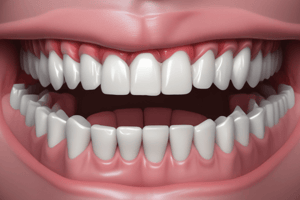Podcast
Questions and Answers
Explain the process of taking a face bow record in dentistry, including the steps involved and the purpose of each step.
Explain the process of taking a face bow record in dentistry, including the steps involved and the purpose of each step.
The process involves seating the patient, marking the points for condylar position, attaching the bite fork to occlusal rims, placing the frame of the face bow, making the condylar rod scales equivalent, recording the anterior reference point, tightening the fork to the frame, removing the face bow, and transferring the record to the articulator. The purpose of each step is to accurately capture the relationship of the maxilla to the transverse hinge axis and to ensure proper mounting of the maxillary cast on the articulator.
What is the vertical dimension of occlusion in dentistry? How is it defined and maintained?
What is the vertical dimension of occlusion in dentistry? How is it defined and maintained?
The vertical dimension of occlusion refers to the length of the face and is defined as the distance between two selected anatomic or marked points. It is maintained by the occlusion of the teeth.
What is the vertical dimension of rest in dentistry? How is it defined and maintained?
What is the vertical dimension of rest in dentistry? How is it defined and maintained?
The vertical dimension of rest refers to the length of the face and is defined as the distance between two selected anatomic or marked points. It is maintained by the balanced tonic contraction of the opening and closing muscles of mandibular movements.
What is the purpose of the U-shaped frame in a face bow in dentistry?
What is the purpose of the U-shaped frame in a face bow in dentistry?
How is the vertical jaw relation categorized in dentistry? What are the components of vertical dimension of rest and vertical dimension of occlusion?
How is the vertical jaw relation categorized in dentistry? What are the components of vertical dimension of rest and vertical dimension of occlusion?



